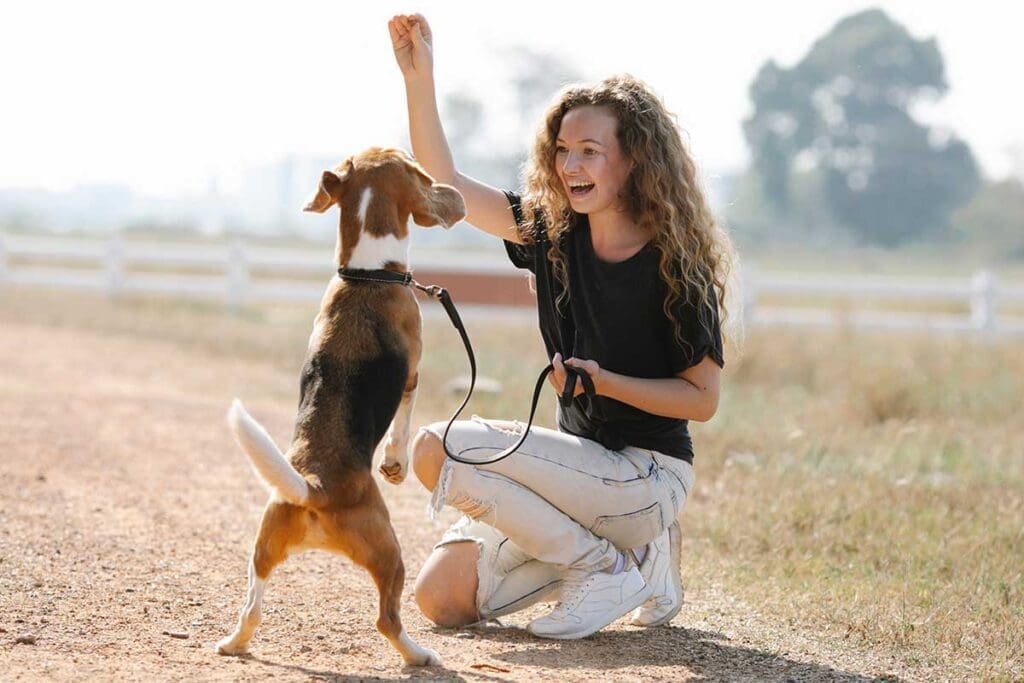For dogs, sound and tone matter, and it turns out dogs are more responsive to directed speech spoken by women, which may explain why women dog trainers appear to be more effective than men. What makes the difference?
Speaking in “Motherese”

“Motherese” is a name researchers give to a style of speech used on babies and very young children. It’s a vocalization in a higher pitched tone of voice — one that is almost musical, and often using many repetitions.
According to experts, a technical way of describing this would be “infant-directed speech.”
In the 1980s, two psychologists at the University of Pennsylvania, Kathy Hirsh-Pasek and Rebecca Treiman, demonstrated that when humans spoke to dogs, they used a language very similar to “Motherese.” They gave this manner of speaking a slang name of “Doggerel,” which is another way of saying “dog-directed speech.”
Additional research over the years has shown that both children and dogs pay closer attention when spoken to in Motherese or Doggerel, Psychology Today reported. More recent studies demonstrated that the brains of young children respond more strongly to Motherese.
Does Motherese Work on Dogs?

A team of investigators at Eötvös Loránd University in Budapest, Hungary, led by Anna Gergely, wanted to find out if dog brains were similarly sensitive to Motherese as the brains of human children.
To test this, they measured the brain activity of 19 family dogs. The canines listened to recordings of speech that were directed at infants, adults, and dogs. Each speech sample contained full sentences recorded by both male and female adult speakers the dogs were unfamiliar with. The speakers engaged in normal positive interactions with their own family dogs, their own babies, or another adult.
The researchers used fMRI (functional magnetic resonance imaging) to measure the brain activity of the dogs. The resulting data revealed that the dogs had special response regions on the left side of dog brains that were slightly to the front of the normal auditory response regions. These areas of the brain responded more to dog- and infant-directed speech than they did to normal speech directed at adults.
What the brain imaging revealed was that, just like human children, the brains of dogs are attuned to exactly the kind of “Motherese” speech patterns that humans typically direct at them.
Further, dogs appear especially sensitive to not only dog-directed speech but also infant-directed speech.
Does the Tone of Female Voices Make Women Better Dog Trainers?

Even without the results of how dog’s brains respond to “Motherese” speech, observational evidence seems to indicate that women might be better at dog training than men.
What evidence? A casual accounting will reveal that the overwhelming majority of trainers of companion dogs are women. The data one researcher collected revealed that four out of five companion dog trainers are women.
Just look at the results of dog obedience competitions in 2022. All of the top 10 obedience dogs for this year had female handlers. The probability of this happening by chance is less than one in a thousand (0.001%).
Researchers believe this may not all come down to skills. A major factor could simply be that the brains of dogs are more tuned to the female voice, especially when using “Motherese,” “Doggerel,” or whatever term you want to give dog-directed speech.
Men make up the majority — and do well at — training hunting dogs, protection dogs, and field dogs. But these more “macho” activities are those that many women have a propensity to shy away from. Perhaps if more women gravitated toward these types of dog training, they might dominate those arenas as well.






